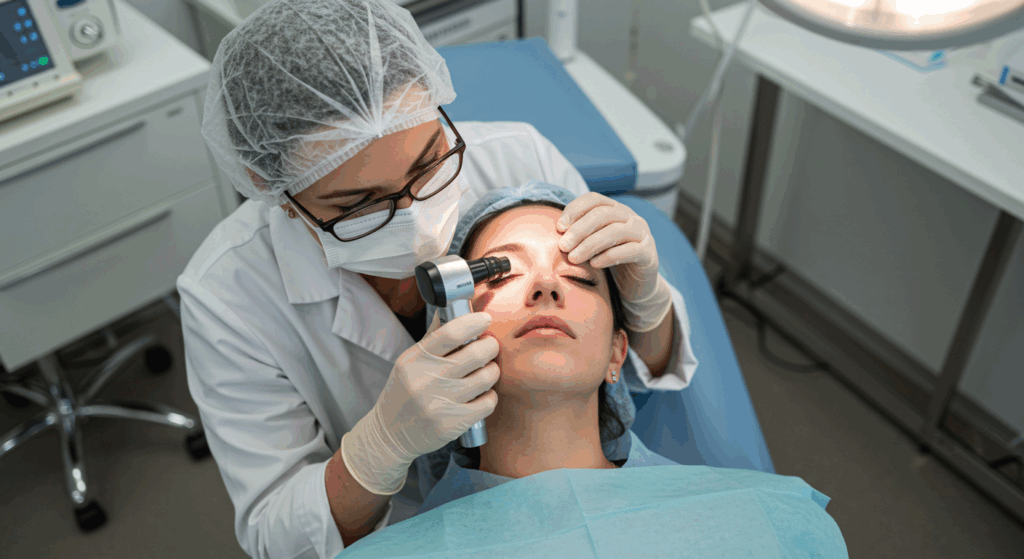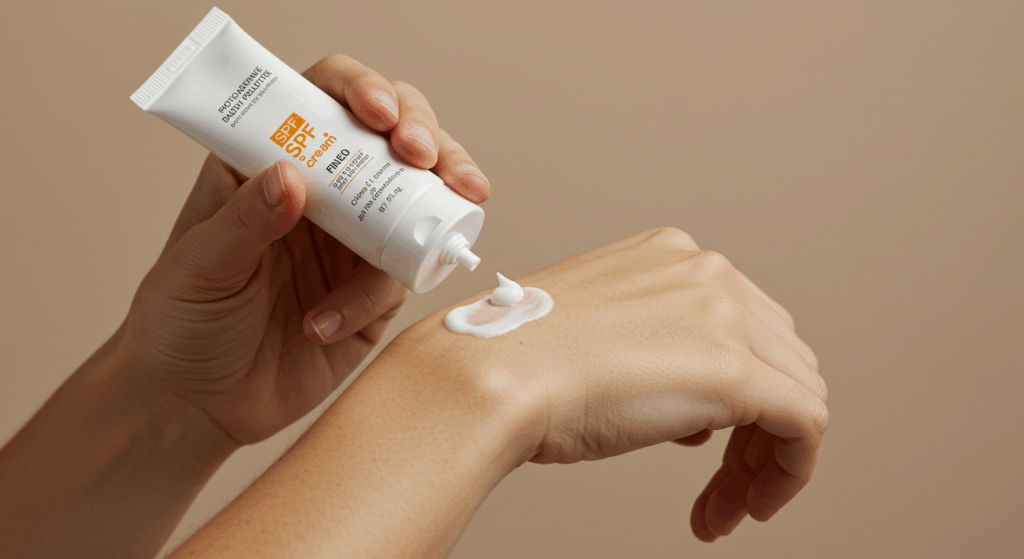As global temperatures rise and weather patterns shift in 2025, the connection between climate change and skin health has never been more critical. At Dr. Ebru Okyay’s clinic in Antalya, we’ve seen firsthand how environmental factors are influencing dermatological conditions. If you’re experiencing unusual skin issues amid changing weather, you’re not alone. This comprehensive guide explores the profound effects of climate change on your skin, from increased UV exposure to pollution spikes, and provides actionable strategies to protect and treat your dermatological health.
In this deep dive, we’ll uncover how rising temperatures, extreme weather, and pollution are altering skin conditions like acne, eczema, and skin cancer risks. Drawing from the latest 2025 research and clinical insights, we’ll equip you with knowledge to safeguard your skin against these environmental threats. Whether you’re battling dryness from arid conditions or flare-ups from humidity surges, understanding these impacts is key to maintaining healthy skin.

Introduction to Climate Change and Its Dermatological Implications
Climate change isn’t just an environmental crisis; it’s a health crisis affecting the body’s largest organ: the skin. In 2025, with record-breaking heatwaves and altered precipitation patterns, dermatologists worldwide are reporting surges in climate-related skin disorders. As a board-certified Hautarzt with over a decade of experience, Dr. Ebru Okyay emphasizes that proactive skincare is essential in this era of environmental flux.
The skin acts as a barrier against external aggressors, but escalating environmental stressors are overwhelming this defense. From prolonged UV radiation due to ozone depletion to increased allergen exposure from shifting pollen seasons, the repercussions are multifaceted. This section sets the stage for understanding how these changes manifest in everyday skin health challenges.

The Direct Effects of Rising Temperatures on Skin Health
Rising global temperatures, a hallmark of climate change, profoundly impact skin physiology. Heatwaves, now more frequent and intense in 2025, lead to excessive sweating, which disrupts the skin’s natural moisture balance. This can exacerbate conditions like rosacea and hyperhidrosis, causing redness, irritation, and discomfort.
Moreover, higher temperatures accelerate skin aging by boosting free radical production, which damages collagen and elastin fibers. Studies from the American Academy of Dermatology in 2025 highlight that individuals in warmer climates experience up to 20% faster wrinkle formation. For patients at our Antalya clinic, where Mediterranean summers are intensifying, we’ve adapted treatments to include advanced hydrating therapies and antioxidant serums to counteract these effects.
Heat-Induced Skin Conditions
Prolonged exposure to high temperatures can trigger heat rash (miliaria), characterized by itchy red bumps from blocked sweat ducts. In vulnerable populations, such as the elderly or those with chronic illnesses, this can lead to severe infections if untreated. Additionally, heat stress compromises the skin barrier, making it more susceptible to bacterial and fungal invasions—a concern we’ve addressed in our guide on Pilzinfektionen und Hautprobleme.
- Prickly Heat: Common in humid, hot environments; treat with calamine lotion and cool showers.
- Sonnenurtikaria: Hives from sun exposure, worsened by climate shifts; antihistamines provide relief.
- Exacerbated Eczema: Dry air from heated environments cracks skin; moisturize frequently.
To mitigate these, staying hydrated internally and externally is crucial. Recommend broad-spectrum sunscreens and lightweight, breathable clothing for daily protection.
| Zustand | Symptome | Climate Link | Behandlung |
|---|---|---|---|
| Heat Rash | Red bumps, itching | Increased sweating in heatwaves | Cool compresses, hydrocortisone cream |
| Rosacea Flare-Ups | Facial redness, visible blood vessels | Higher temperatures dilate vessels | Topical metronidazole, laser therapy |
| Accelerated Aging | Wrinkles, sagging | Free radical surge from heat | Retinoids, vitamin C serums |
This table summarizes key heat-related skin issues, highlighting the urgent need for climate-aware dermatology practices.
UV Radiation and Ozone Depletion: Rising Skin Cancer Risks
Climate change exacerbates UV exposure through stratospheric ozone thinning and prolonged sunny periods. In 2025, the World Health Organization reports a 15% increase in melanoma cases linked to environmental changes. UV rays penetrate deeper into the skin, causing DNA damage that leads to mutations and cancer development.
At Dr. Okyay’s practice, we prioritize early detection with regular skin checks. Basal cell carcinoma, squamous cell carcinoma, and melanoma are on the rise, particularly in regions like Antalya with high sun exposure. Preventive measures include daily SPF 50+ application, even on cloudy days, as UVA rays persist regardless of weather.
Protecting Against UV in a Changing Climate
Beyond sunscreen, UPF-rated clothing and wide-brimmed hats are essential. For those with photosensitive disorders, window films blocking UV can help indoors. Our clinic offers phototherapy for conditions like psoriasis, but warns against overexposure in altered climates.
- Apply sunscreen 30 minutes before going out; reapply every 2 hours.
- Seek shade during peak UV hours (10 AM – 4 PM).
- Monitor vitamin D levels; supplement if deficiency arises from avoidance.
Research from 2025 underscores that consistent protection reduces skin cancer risk by up to 50%. For more on chronic conditions potentially worsened by UV, see our article on chronische Hauterkrankungen.
| Skin Cancer Type | UV Link | Tipps zur Prävention | Detection Signs |
|---|---|---|---|
| Melanoma | Deep UV penetration | SPF 50+, self-exams | Asymmetrical moles, changing size |
| Squamous Cell | Surface damage | Hats, long sleeves | Scaly red patches |
| Basal Cell | Chronic exposure | Avoid tanning beds | Pearly bumps, bleeding |
Pollution and Extreme Weather: Aggravating Allergic and Inflammatory Skin Disorders
Air pollution, intensified by wildfires and urban heat islands in a warming world, deposits particulate matter on the skin, triggering inflammation. In 2025, cities like Antalya face higher PM2.5 levels during dry seasons, correlating with spikes in atopic dermatitis and acne.
Extreme weather events, such as floods and droughts, alter humidity and allergen distribution. Pollen seasons are lengthening, worsening hay fever-related eczema. Ozone pollution from heat-trapped emissions irritates sensitive skin, leading to contact dermatitis.
Impact on Common Conditions
Eczema sufferers report more frequent flares due to polluted, variable air quality. Acne vulgaris intensifies from oil gland hyperactivity in humid shifts. For comprehensive management, consult our eczema overview and consider professional evaluation.
- Pollution Barrier Creams: Use products with antioxidants to neutralize free radicals.
- Post-Weather Cleansing: Gentle cleansers remove residues after storms or dusty days.
- Anti-Inflammatory Diets: Omega-3s and probiotics support skin resilience.
Clinical trials in 2025 show that urban dwellers using HEPA filters indoors reduce skin irritation by 30%. Extreme weather also spreads vector-borne diseases like Lyme, affecting skin with rashes.
| Environmental Factor | Skin Condition Aggravated | Symptome | Schadensbegrenzung |
|---|---|---|---|
| Air Pollution | Acne, Dermatitis | Blackheads, redness | Double cleansing routine |
| Wildfire Smoke | Schuppenflechte | Scaling, itching | Humidifiers, topical steroids |
| Extended Pollen Seasons | Allergische Reaktionen | Hives, swelling | Antihistamine creams |

Protective Strategies and Treatments for Climate-Resilient Skin
To combat these challenges, a multi-layered approach is vital. Start with personalized skincare regimens tailored to your local climate projections. At our clinic, we use AI-driven assessments to predict and prevent flare-ups based on 2025 weather data.
Treatments range from prescription topicals for acute issues to laser therapies for long-term repair. Biologics for severe eczema have revolutionized care, offering relief where environmental triggers persist.
Daily Routines and Innovations
Incorporate barrier-repair moisturizers with ceramides to fortify against pollutants. For UV protection, mineral sunscreens with zinc oxide are ideal for sensitive skin. Emerging 2025 innovations include smart fabrics that release moisturizers and apps tracking personal UV exposure via satellite data.
- Layer skincare: Cleanser, serum, moisturizer, sunscreen.
- Environmental monitoring: Use air quality apps to adjust routines.
- Professional consultations: Schedule annual skin health check-ups.
For those unsure where to begin, our Fragen an Ihren Dermatologen resource can guide your next visit.
Abschluss
Die wichtigsten Erkenntnisse
- Climate change in 2025 amplifies skin issues through heat, UV, and pollution, increasing risks for cancer and inflammation.
- Proactive protection with sunscreen, hydration, and clean air practices can mitigate most effects.
- Early intervention via dermatological expertise prevents long-term damage; monitor changes closely.
- Adopting sustainable habits benefits both planetary and personal health.
Nächste Schritte
Assess your skin’s current state and environmental exposures. Book a consultation with Dr. Ebru Okyay to create a customized plan. Stay informed on climate updates and adjust your skincare accordingly for resilient, healthy skin.
Häufig gestellte Fragen (FAQs)
How does climate change specifically affect sensitive skin?
Sensitive skin is more prone to irritation from heat, pollution, and UV changes. Use gentle, fragrance-free products and consult a dermatologist for barrier-strengthening treatments.
Can climate change worsen acne?
Yes, increased humidity and pollution can clog pores. Maintain a consistent cleansing routine and consider salicylic acid treatments.
What role does sunscreen play in climate-impacted dermatology?
Sunscreen is crucial; opt for broad-spectrum SPF 50+ to counter heightened UV exposure from ozone changes.
How to protect skin during extreme weather events?
During heatwaves or storms, prioritize hydration, avoid irritants, and use protective clothing to shield from elements.
Are there new treatments for climate-related skin cancer?
In 2025, immunotherapy and targeted therapies offer promising options; early detection remains key.
Does indoor air quality matter for skin health amid climate change?
Absolutely; use purifiers to reduce pollutants that infiltrate homes during wildfires or high-pollution days.
Can diet help combat environmental skin damage?
Antioxidant-rich foods like berries and greens support skin repair against free radicals from pollution and heat.
When should I see a dermatologist for climate-related issues?
If you notice persistent changes like new rashes or worsening conditions, seek professional advice promptly.
Dr. Ebru Okyay is a leading dermatologist in Antalya, specializing in environmental dermatology. Visit drebruokyay.com for more insights on maintaining skin health in a changing world.
